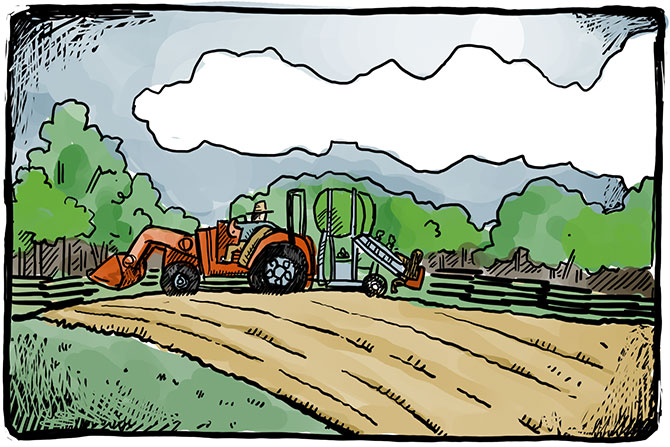The Gardens at Cornman Farms

A chat with Farm Manager Mark Baerwolf
Mark Baerwolf is one of the original Roadhouse employees. Since 2005, Mark has divided his time between cooking at the Roadhouse and managing the agricultural operations at Cornman Farms. He helped open the restaurant, and soon found himself enamored of Executive Chef Alex Young’s dream of bringing fresh, pesticide-free produce to the dinner plate. When the opportunity to work on the farm came along, Mark jumped at the chance.
These days Mark spends his summers outside tending the crops growing on the farm and his winters poring through seed and farm equipment catalogs and planning for the next year’s harvest. You’ll still find him in the Roadhouse kitchen occasionally though now he’s more than likely preparing food that he raised.
This season has brought some big changes to Cornman. With the opening of the event barn at the farm house, we have also created a new garden space on the property. I toured the gardens with Mark out at the farm to learn a bit more about Zingerman’s work to bring the farm to the table.
“Heirloom vegetables are like a step back in time. They’re history on display.” Mark is talking about the new garden beds at Cornman Farms. The beds lie on the low ground near the restored barn, and Mark and his crew are busy planting herbs in the hot sun. His face is flushed, and he’s holding a handful of chive plants. “But heirlooms and such are not just about history, they’re also about connections to family and friends.”
Take the chives, for example. “They came from a friend of mine. They’re just chives, but they represent something deeper. They have a history that’s not really heirloom, but it’s important.” The plants, it turns out, are direct descendants of chives that were brought to Michigan nearly 70 years ago by Polish immigrants who’d originally arrived in Philadelphia in the early 20th century. When they decided to move to the Mitten in the late 40’s, the chives, and a bunch of other herbs and vegetables, traveled with them. “Like a lot of people who lived through that time,” says Mark, “they always had a little Depression survival garden going.”
“These are walking onions.” Mark goes on to describe the plant’s ability to spread by “walking.” When the onion stalks reach a certain height, they develop a tiny onion bulb at the top of the plant. As the bulb grows larger, it pulls the long stalk over to the ground, where it roots in. As the new bulb matures, it grows its own stalk and tiny bulb, and the process is repeated. This is how the plant “walks” itself over open ground to proliferate. “I got the walking onions from a server at the Roadhouse,” he says.
The gardens don’t really have an official name yet, but Cornman staff have been calling them the “Educational Garden” to differentiate them from the vast expanse of rows known as the “Production Garden,” which supplies the Roadhouse. “What you see here,” he says, gesturing to the new beds in front of the barn, “is a reflection of what’s happening out in the production areas. We wanted people to see a sample of the varieties of heirlooms we’re growing out here.” The garden integrates the ideas of traditional, beneficial, and sustainable farming practices they’ve been using at Cornman Farms for the past eight years.
Back inside the farmhouse, Mark shows me a website run by Slow Food USA called the Ark of Taste. The site is a knowledge repository of our collective food heritage here in the US. Listed within are all manner of heirloom fruits and vegetables, animal breeds, forgotten and “lost” foods, and even traditional and heirloom recipes. “I encourage the chefs at the Roadhouse to look here for inspiration. There’s so much great stuff here.”
Mark goes on to tell me that when it comes to the many varieties of heirloom tomatoes, squash, and peppers listed on the Ark of Taste, most are currently grown on the farm. The exceptions are the varietals more suited to southern climes, unable to handle our northern winters. “This year, we’ve got 40-45 different types of heirloom tomatoes growing out there,” says Mark. “Many of these heirloom breeds have documentation going back to the Civil War, some back nearly 200 years!” He also makes the point that the very oldest heirlooms were shared with European settlers by indigenous peoples who had likely been cultivating them for thousands of years.
“We really wanted to tap into this, to use heirloom breeds and recipes. A great example is the pepper vinegar we serve at the Roadhouse.” The recipe comes from an old Pennsylvania Dutch Civil War-era cookbook called Die Geschickte Hausfrau (“The Handy Housewife”) that used a spicy hinkelhatz pepper. Mark and Alex stared growing the hinkelhatz at the farm, added it to a good cider vinegar, and it has become a staple at the restaurant. “We used the heirloom pepper, the heirloom recipe. It was great way of carrying this food forward to the 21st century.”
When fully planted, the new garden will be a sort of microcosm of the larger farm. Guests will be able to stroll between the beds and see heirloom varieties of squash, peppers, tomatoes, potatoes, beans, and herbs of all types. And even though some might be “just chives,” they’ll all have a story. And whether it’s a tale of deep history from the early days of North American civilization, a connection to generations who came before, or just a great flavor, Mark is sure to know the story. And if you have a few minutes, he’d be happy to share it with you.
Want to learn more? Sign up for a tour of Cornman Farms and hear it from the people who work there! More information here.




Zingerman’s Art for Sale